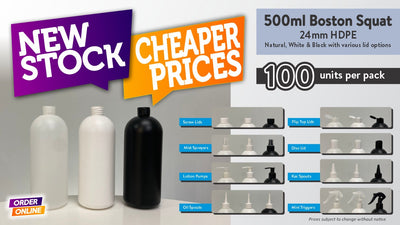If you’re comparing PET vs HDPE bottles in South Africa, this guide explains the differences in clarity, chemical resistance, recyclability, and cost so you can select the right bottle for your formula and brand. Both plastics are widely used in plastic packaging materials, but each excels in different applications. Whether you’re launching a beverage, a cosmetic line, or a household cleaner, the packaging you choose will influence shelf appeal, product protection, logistics, and sustainability.
Quick links: All Bottles & Containers · Bottle Printing · Deliveries & Collections · FAQs · Johannesburg Showroom · Contact
What Is PET?
PET (Polyethylene Terephthalate) is a lightweight, durable polyester used extensively for bottles in food, beverage, and personal care. It’s prized for its crystal clarity, stable barrier properties, and broad recyclability (commonly into rPET). These qualities make PET a go-to for transparent retail packaging where product visibility matters.
What Is HDPE?
HDPE (High-Density Polyethylene) is a tough, opaque-to-translucent resin known for impact strength and chemical resistance. It’s the preferred choice for household cleaners, chemicals, and many industrial products where robustness and light protection outweigh the need for transparency.
PET vs HDPE Bottles: Side-by-Side Comparison
| Feature | PET Bottles | HDPE Bottles |
|---|---|---|
| Appearance | Clear, glossy; showcases the product | Opaque/translucent; hides contents, protects from light |
| Strength & Impact | Rigid and lightweight; suitable for retail handling | Highly impact-resistant; excellent for rough handling |
| Chemical Resistance | Good for many consumer liquids | Superior for detergents, bleaches, solvents |
| Weight | Generally lighter; transport-efficient | Slightly heavier; very durable |
| Recyclability | Widely recycled; strong rPET ecosystem | Recyclable; often down-cycled depending on stream |
| Best For | Beverages, edible oils, cosmetics where clarity sells | Cleaning, industrial, light-sensitive or aggressive formulas |

Clarity & Shelf Appeal
If you want consumers to see the product colour and texture, PET’s transparency delivers premium shelf impact (ideal for water, juices, edible oils, many personal-care liquids). When discretion or UV protection is more important, HDPE’s opacity is advantageous, commonly used for bleaches, detergents, and sensitive formulas.
Handling, Transport & Weight
PET is typically lighter, which helps reduce transport costs and associated emissions — a meaningful factor in national distribution. HDPE offers extra robustness and impact strength, useful for heavier or aggressive liquids and more demanding supply chains.
Recyclability & Sustainability (South Africa)
Both resins are recyclable in South Africa. PET benefits from a mature local recycling ecosystem (supporting rPET production and circularity). HDPE is also recycled, though streams may favour down-cycling into durable goods. For brands pursuing circular packaging and on-pack recycling claims, PET’s infrastructure can be especially advantageous.

Chemical Compatibility & Product Safety
- PET: beverages, edible oils, many cosmetics and personal-care liquids due to clarity and barrier performance.
- HDPE: detergents, bleaches, industrial and automotive fluids thanks to superior chemical resistance and toughness.
Always test with your actual formula (including fragrance, pH, and any solvents). Your PackNet rep can help with compatibility checks.
Branding & Customisation
PET supports sleek, transparent designs and premium labels. HDPE supports functional forms (including handles on larger sizes) and bold colours. If you need branded decoration, see Bottle Printing for options.
Cost Drivers
True cost depends on size, shape, order volume, closures (pumps, triggers, caps), and decoration. PET’s lightweighting can improve logistics costs; HDPE’s ruggedness can reduce damages and returns for heavy-duty products. Local sourcing helps minimise freight, import delays, and volatility.
Industry-Specific Recommendations
| Industry | Recommended Material | Why |
|---|---|---|
| Beverage & Food | PET | Clarity, shelf appeal, established recycling pathways |
| Household Cleaning & Detergents | HDPE | Chemical resistance and toughness |
| Cosmetics & Personal Care | PET / HDPE | Depends on formula viscosity and brand aesthetic |
| Industrial & Automotive | HDPE | Handles rough handling and aggressive fluids |
| Pharmaceutical & Healthcare | HDPE | Opacity and protection for light-sensitive products |
How to Decide: A Practical Checklist
- Product & formula: Water-based, oil-based, pH, solvents, fragrance?
- Appearance: Do you need crystal clarity (PET) or opaque protection (HDPE)?
- Handling: Will the bottle face rough transport or industrial environments?
- Sustainability: Recycled content targets and consumer recycling expectations?
- Operations: Filling temperature, closure compatibility, labelling, decoration?
- Budget & logistics: Unit cost, MOQs, nationwide shipping, lead time?
Local Advantage: Source from a Bottle Supplier in Johannesburg
Working with a bottle supplier in Johannesburg gives you local sampling, shorter lead times, and national delivery support. You can also visit the Johannesburg showroom to compare PET and HDPE bottles in person and discuss printing options on site.
Next Steps
- Browse All Bottles & Containers to shortlist sizes and closures.
- Choose your material: PET for clarity/aesthetics; HDPE for chemical resistance/toughness.
- Discuss branding and print with our Bottle Printing team.
- Confirm delivery options and timelines via Deliveries & Collections.
- Have questions? See FAQs or Contact us.
Conclusion
There’s no universal winner in the PET vs HDPE bottles South Africa debate — the right choice depends on your formula, brand positioning, and logistics. PET delivers clarity and strong recycling infrastructure; HDPE delivers chemical resistance and rugged performance. Choose the material that aligns with your product needs, and leverage local expertise to accelerate development and reduce risk.
Visit PackNet | Packaging Supplier in Johannesburg
Address: 11 Springbok Rd, Longdale, Johannesburg, 2093
Phone: 011 474 0360
Email (Website Orders): mbali.s@packnet.co.za
WhatsApp: 078 337 1821
Website: packnet.co.za
Facebook: facebook.com/PackNetSA
Instagram: instagram.com/packnetsa
Google Maps: Find us here
FAQs: PET vs HDPE in South Africa
Are PET bottles recyclable in South Africa? Yes. PET is widely collected and reprocessed (including food-grade rPET capacity) through local industry programmes.
When should I choose HDPE instead of PET? When your product needs superior chemical resistance, opacity, or heavy-duty handling.
Can I print directly on PET or HDPE bottles? Yes. See Bottle Printing for decoration options and guidance.






